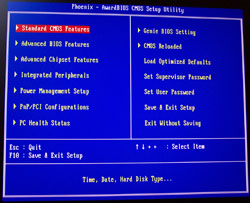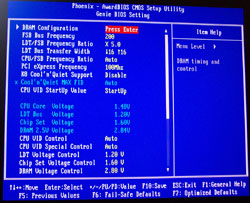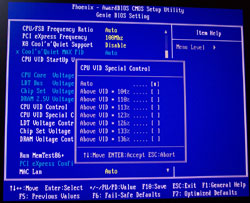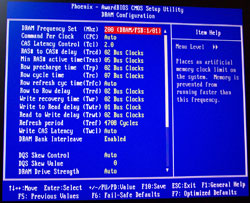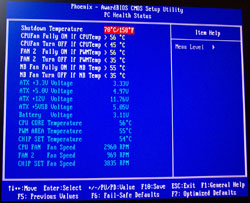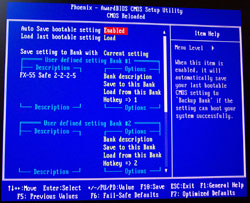DFI LanParty UT nF4 SLI-D - BIOS
DFI stick with an AWARD BIOS, adding in their own sections for board-specific options. I'll go through the main screens.You can just about see the Genie BIOS Setting and CMOS Reloaded settings on the first page of the BIOS you'll hit after entering it.
The Genie BIOS page is where all the action happens, in terms of manipulating the processor, memory setup and voltages for everything. You get the aforementioned 2.5V to 3.2V, or 3.2V to 4.0V ranges for memory, depending on jumper configuration. For CPU VID (voltage ID), you get an option to force VID to one of the standard voltages, then apply a multiplier on top of that.
That 136% setting, with a forced base VID of 1.55V will see your processor at the high side of 2.1V. For the overclocker with phase-change only. Memory adjustment sees you faced with all the settings you're used to, such as commmand rate, CL, Trp-Trcd-Tras and frequency, and many others that are usually hidden.
In early BIOS revisions, the DFI had trouble setting Tref correctly for some brands of memory, causing problems (serious problems), which is now fixed. Your best plan of attack when tweaking memory is to first load the BIOS's safe settings, then go from there.
The PC Health section is what's given me most grief, during testing. The settings control the shutdown and full speed settings of your CPU fan, the fan you connect to the PWM fan header and the nForce4 chip's fan. Look at the correlation between the full speed settings I've chosen, and the actual temperatures measured for them. You have a dilemma in how to adjust the settings to keep the board from ramping up the fans to maximum and back down to something slower, as the temperatures constantly cross your threshold.
The key is to set the full speed temperature setting quite high and the turn off setting quite low, hoping it'll modulate linearly in between. It doesn't happen well in practice, with especially the chipset fan really needing to spin at full speed as much as possible. It gets hot and the temperature, at least in the test chassis I use (an Akasa Eclipse 62), will want to creep towards the upper limit you set. The knock-on effect is the fan on the nForce4 chip goes crazy more often than not. Annoying.
The last notable BIOS screen is that for CMOS Reloaded.
CMOS Reloaded lets you save four copies of your BIOS settings to profiles that you can access easily, name to fit (you can see my own FX-55 safe settings that I know will boot) and access using a hotkey. You can then load settings on boot by pressing your key and have them loaded without having to enter the BIOS. It's a small time saving measure but one that brings a smile to your face whenever you use it.
There are other screens for setting boot priority and similar, advanced chipset features, power management and Plug n Play and PCI settings.
Overall
If you were in any doubt that the board was for the seasoned enthusiast, the BIOS confirms that easily. Lots of adjustment of all the the important parameters that govern a board's performance are available. The memory voltage options especially are what certain people have been crying out for (3.6V stable Vdimm for Winbond BH-5), but which are rightly locked away initially, to save accidents with DRAMs that don't like such high voltage. There's masses of CPU Vcore to play with, almost all the parameters to tune on the Athlon 64's memory controller and CMOS Reloaded to help you make some sense of it all.It's a BIOS that almost has me yearning for a Gigabyte style CTRL+F1 to unlock, unadvertised hidden set of screens for adjusting some of the more obscure parameters that have a higher chance of causing instability and issues. Make of that what you will. A tweaker's heaven, otherwise.






